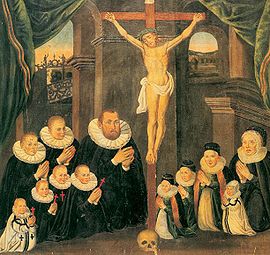.gif)
Friedrich (Glass-Maker Family)
Encyclopedia
The Friedrich are the most ancient German-Bohemian glass-maker family.

(also called Bohemian Crystal). In pre-Hussite
times they produced amazing works of vitreous art near Daubitz, nowadays called Doubice
. During the 16th and 17th centuries, as a result of the family’s development of their glass factory in Oberkreibitz, today Horní Chribská, Bohemian glass art enjoyed its first heyday.
The expansion of this glass-maker family over many European countries is unparalleled. Its hut master dynasties made glass history in Bohemia
, Silesia
, Austria
, Tyrol
and Slovenia
. Its glass-makers proved their artistic skills and technological experience in Brandenburg
, Saxony
, Thuringia
, Bavaria
, Styria, Slovakia
, Croatia
and so on. The well-known glass artist Friedrich Egermann also ranked among the family’s descendants as the natural historian and explorer of South America Thaddäus Haenke
.

History
From as early as 750 years ago, the shadowy picture of the oldest German-Bohemian glass-maker family Friedrich emerges, who contributed greatly towards the creation of the world-famous Bohemian glassBohemian glass
Bohemian glass, or Bohemia crystal, is a decorative glass produced in regions of Bohemia and Silesia, now in the current state of the Czech Republic, since the 13th century. Oldest archaeology excavations of glass-making sites date to around 1250 and are located in the Lusatian Mountains of...
(also called Bohemian Crystal). In pre-Hussite
Hussite
The Hussites were a Christian movement following the teachings of Czech reformer Jan Hus , who became one of the forerunners of the Protestant Reformation...
times they produced amazing works of vitreous art near Daubitz, nowadays called Doubice
Doubice
Doubice is a village and municipality in Děčín District in the Ústí nad Labem Region of the Czech Republic.The municipality covers an area of , and has a population of 106 ....
. During the 16th and 17th centuries, as a result of the family’s development of their glass factory in Oberkreibitz, today Horní Chribská, Bohemian glass art enjoyed its first heyday.
The expansion of this glass-maker family over many European countries is unparalleled. Its hut master dynasties made glass history in Bohemia
Bohemia
Bohemia is a historical region in central Europe, occupying the western two-thirds of the traditional Czech Lands. It is located in the contemporary Czech Republic with its capital in Prague...
, Silesia
Silesia
Silesia is a historical region of Central Europe located mostly in Poland, with smaller parts also in the Czech Republic, and Germany.Silesia is rich in mineral and natural resources, and includes several important industrial areas. Silesia's largest city and historical capital is Wrocław...
, Austria
Austria
Austria , officially the Republic of Austria , is a landlocked country of roughly 8.4 million people in Central Europe. It is bordered by the Czech Republic and Germany to the north, Slovakia and Hungary to the east, Slovenia and Italy to the south, and Switzerland and Liechtenstein to the...
, Tyrol
County of Tyrol
The County of Tyrol, Princely County from 1504, was a State of the Holy Roman Empire, from 1814 a province of the Austrian Empire and from 1867 a Cisleithanian crown land of Austria-Hungary...
and Slovenia
Slovenia
Slovenia , officially the Republic of Slovenia , is a country in Central and Southeastern Europe touching the Alps and bordering the Mediterranean. Slovenia borders Italy to the west, Croatia to the south and east, Hungary to the northeast, and Austria to the north, and also has a small portion of...
. Its glass-makers proved their artistic skills and technological experience in Brandenburg
Brandenburg
Brandenburg is one of the sixteen federal-states of Germany. It lies in the east of the country and is one of the new federal states that were re-created in 1990 upon the reunification of the former West Germany and East Germany. The capital is Potsdam...
, Saxony
Saxony
The Free State of Saxony is a landlocked state of Germany, contingent with Brandenburg, Saxony Anhalt, Thuringia, Bavaria, the Czech Republic and Poland. It is the tenth-largest German state in area, with of Germany's sixteen states....
, Thuringia
Thuringia
The Free State of Thuringia is a state of Germany, located in the central part of the country.It has an area of and 2.29 million inhabitants, making it the sixth smallest by area and the fifth smallest by population of Germany's sixteen states....
, Bavaria
Bavaria
Bavaria, formally the Free State of Bavaria is a state of Germany, located in the southeast of Germany. With an area of , it is the largest state by area, forming almost 20% of the total land area of Germany...
, Styria, Slovakia
Slovakia
The Slovak Republic is a landlocked state in Central Europe. It has a population of over five million and an area of about . Slovakia is bordered by the Czech Republic and Austria to the west, Poland to the north, Ukraine to the east and Hungary to the south...
, Croatia
Croatia
Croatia , officially the Republic of Croatia , is a unitary democratic parliamentary republic in Europe at the crossroads of the Mitteleuropa, the Balkans, and the Mediterranean. Its capital and largest city is Zagreb. The country is divided into 20 counties and the city of Zagreb. Croatia covers ...
and so on. The well-known glass artist Friedrich Egermann also ranked among the family’s descendants as the natural historian and explorer of South America Thaddäus Haenke
Thaddäus Haenke
Thaddäus Xaverius Peregrinus Haenke was a geographer and explorer in South America.-Biography:Thaddaeus Haenke was born of ethnic German extraction in the Bohemian village of Kreibnitz , near the Sudeten Mountains in 1761...
.

